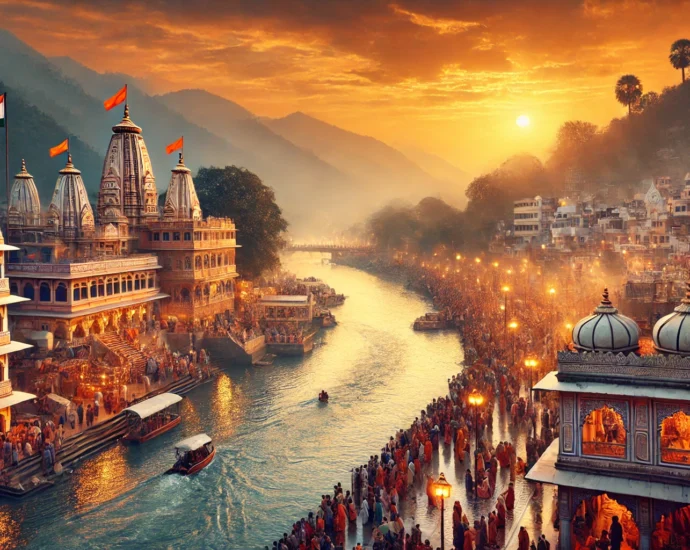Unravel All About Haridwar History: A Journey Through Time, From Vedic Origins to Its Role as a Sacred Pilgrimage Site
Introduction
Nestled on the banks of the sacred Ganges River, Haridwar is one of India’s oldest and holiest cities. A convergence of mythology, spirituality, and history, this revered destination has stood the test of time, serving as a gateway to divinity. From its mentions in ancient scriptures to its prominence in modern Hinduism, Haridwar has continuously been a center for seekers, sages, and pilgrims. This journey through time explores the evolution of Haridwar from its Vedic origins to its esteemed position as a pilgrimage hub.
The Timeless Significance of Haridwar
Haridwar as the Gateway to the Gods
Haridwar, meaning “Gateway to Hari (Vishnu),” is considered the threshold to the Char Dham pilgrimage—Badrinath, Kedarnath, Gangotri, and Yamunotri. It is the first stop for devotees embarking on their spiritual journey into the Himalayas, making it a pivotal religious center.
Why Haridwar Holds a Sacred Place in Hinduism
Haridwar is one of the seven holiest cities (Sapta Puri) in Hinduism. Its sanctity is linked to the belief that taking a dip in the Ganges at Haridwar absolves one of sins and grants liberation (moksha). The city’s spiritual magnetism draws millions of devotees every year, reinforcing its religious prominence.
The Eternal Connection Between Haridwar and the Ganges
The Ganges, which descends from the Gangotri Glacier, finds its first major entry into the plains at Haridwar. This confluence has made Haridwar a spiritual epicenter, where sacred ghats like Har Ki Pauri witness daily rituals, prayers, and the renowned Ganga Aarti.
Haridwar in Vedic Times
References to Haridwar in Ancient Vedic Texts
Haridwar is mentioned in the Vedas and Puranas as Mayapuri and Gangadwara, signifying its sacred importance. Ancient texts describe it as a place where sages performed rigorous penance and divine beings descended to bless devotees.
The Mythological Origins of Haridwar’s Name
The name “Haridwar” is derived from two interpretations: one linking it to Lord Vishnu (Hari) and the other to Lord Shiva (Har). Legends suggest that Haridwar was sanctified by the footprints of Vishnu and that Shiva blessed it as a place of penance.
Haridwar’s Role in Early Hindu Rituals and Traditions
Since Vedic times, Haridwar has been a site for yajnas (fire rituals), tapasya (meditation), and pilgrimage. The city’s ghats have long served as the backdrop for sacred rites, reinforcing its spiritual legacy.
Haridwar in Hindu Mythology
Legends of Lord Shiva and Haridwar
Haridwar is associated with several Shiva legends, including the tale of Bhagirath, who performed intense penance to bring the Ganges to Earth. The city also hosts temples dedicated to Shiva, strengthening its divine aura.
The Story of the Sagar Manthan and the Drops of Amrit
According to Hindu mythology, during the churning of the ocean (Samudra Manthan), drops of Amrit (nectar of immortality) fell at four places, including Haridwar. This event gave rise to the grand Kumbh Mela tradition.
The Connection of Haridwar with the Five Sacred Pilgrimage Sites (Panch Tirth)
Haridwar is home to the five significant pilgrimage sites—Har Ki Pauri, Kushavarta Ghat, Mansa Devi Temple, Chandi Devi Temple, and Kankhal. These sites continue to attract devotees seeking divine blessings.
The Influence of Haridwar in Ancient Dynasties
The Role of Haridwar During the Maurya and Gupta Empires
The Mauryan and Gupta periods saw Haridwar flourish as a center of learning and trade. Ashoka’s inscriptions reference the city’s importance, and scholars thrived here, contributing to Hindu philosophy.
The Impact of Buddhism and Jainism on Haridwar
Though predominantly Hindu, Haridwar witnessed Buddhist and Jain influences, with monks and ascetics using it as a retreat for meditation and discourse.
How Haridwar Became a Hub for Ancient Scholars and Sages
Rishis such as Markandeya and Dattatreya are believed to have meditated in Haridwar, solidifying its reputation as a seat of wisdom and enlightenment.
The Rise of Haridwar as a Religious Center
The Establishment of Famous Temples and Ashrams
Temples like Mansa Devi, Chandi Devi, and Daksheshwar Mahadev were established over centuries, attracting devotees and reinforcing Haridwar’s status as a religious nucleus.
The Spiritual Leaders Who Shaped Haridwar’s Identity
Saints like Swami Vivekananda and Guru Nanak visited Haridwar, influencing its spiritual discourse and strengthening its religious significance.
How Haridwar Became a Key Destination for Pilgrims
Haridwar’s growing religious importance led to a surge in pilgrimage, with ashrams and dharamshalas providing refuge to spiritual seekers from across India.
The Kumbh Mela and Its Historical Significance
The Origins of the Kumbh Mela Tradition in Haridwar
The Kumbh Mela, held once every 12 years, dates back thousands of years, commemorating the celestial battle over Amrit.
The Rituals and Ceremonies of the Kumbh Mela
Millions of devotees, sadhus, and ascetics converge in Haridwar to take a holy dip in the Ganges, perform yajnas, and partake in religious discourses.
How the Kumbh Mela Transformed Haridwar Over the Centuries
With each Kumbh Mela, Haridwar has grown in stature, becoming an international religious spectacle and a cultural extravaganza.
The Role of the Ganges in Haridwar’s History
The Spiritual Importance of the River Ganges
The Ganges is not just a river but a lifeline of faith. Haridwar remains its most sacred gateway.
The Legends of Ma Ganga Descending to Earth
King Bhagirath’s penance led to the descent of Ganga, making Haridwar the first point of its earthly journey.
The Impact of the Ganges on Haridwar’s Culture and Economy
From supporting ancient settlements to modern tourism, the Ganges has been Haridwar’s economic and cultural backbone.
Conclusion
Haridwar remains an eternal beacon of faith, where ancient traditions blend seamlessly with modernity. Its temples, legends, and spiritual ambiance ensure that it continues to be a sacred pilgrimage site for generations to come.












